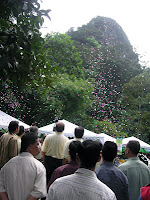With the declaration of the Park in August 2005, it was only a matter of time for the Park to be a legally protected entity.
On 25 January 2007, the Selangor State Government gazetted over 91,144 hectares as ‘state park’ under the National Forestry Act, Selangor Enactment 2005, with the promise to gazette the remaining areas, including the Klang Gates Quartz Ridge, in the near future. This date, the date the gazette was published, is what TrEES considers the official birthday of Taman Warisan Negeri Selangor.
It had taken less than 5 years from the start of the “Project to Establish the Selangor State Park” for the Park to become a reality. The Park is testament to the commitment and focus of all parties involved who were determined to ensure that the Park is protected and would continue to the lifeforce of Selangor, KL and Putrajaya.
In March 2010, the Klang Gates Ridge was gazetted as part of the Park, and the remaining areas after that. The Park is the third largest park in Peninsula Malaysia, and the Klang Gates Quartz Ridge is believed to be the longest quartz outcrop in the world!
The forests protect some of the state and nation’s most vital natural resources including:
- The water supply for the state of Selangor, and the Federal Territories of Kuala Lumpur and Putrajaya – the most populated region in the country. The major rivers in Selangor originate from this area and the Park protects more than 90% of Selangor, KL and Putrajaya’s water supply.
- Biodiversity -- The natural species richness of the Park area includes much of the 3140 vascular plant species recorded for the whole Selangor State; 114 mammal species; 355 birds and over 350 butterfly species.
- The highlands & unique habitats – the Klang Gates Quartz Ridge, one of the longest quartz outcrops in the world is a significant feature found in the area.
- The steep slopes and prevents flooding downstream – The area is essential in regulating surface runoff, minimizing flood peaks and reducing downstream sedimentation. About 76% of the area lies above an elevation of 300 m, with 9.5% above 1000 m. Also, at least 50% of this area has slopes greater than 20 degrees, making it unsuitable for most, if not all, types of development.
The area is also one of the few sizeable, multi-use forested areas in close proximity to a major urban area in the world. In addition to its ecological functions, the forests also are a critical source for relaxation, research and education for residents of Selangor, the nation and the world.
TrEES continues to monitor and submit feedback, letters and opinions on the Park. TrEES is concerned for the Park due to the intense pressure of the urban community that surrounds it and continues to urge the authorities to act quickly to conserve and protect this Park.
Let us all say “Happy Birthday” to Taman Warisan Negeri Selangor, and give thanks for all that the Park gives to us.














